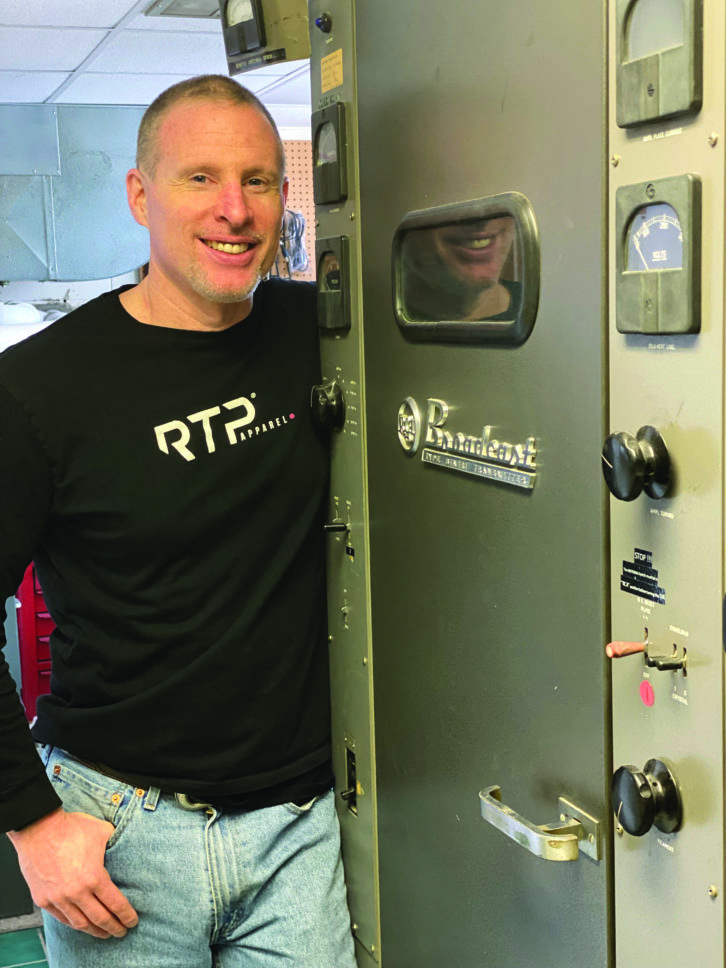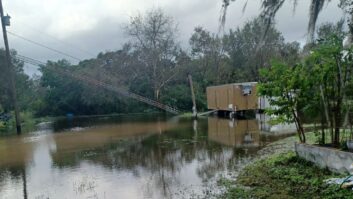A low-power FM station in northeastern Ohio is at risk of being displaced by a proposed new full-service station in the area.
Western Radio Group has filed a petition for rulemaking with the FCC requesting an amendment to the Table of Allotments to make 102.3 MHz available for auction for the purpose of signing on a 6,000-watt nondirectional FM primary station to serve Dennison, Ohio, a community of 2,709 in Tuscarawas County.
WDNP(LP), a low-power FM station licensed to Dover, Ohio, and operating on 102.3 MHz would be displaced by the full-power allotment, according to the group’s technical exhibit filed with the FCC.
To stay on the air, the LP100 station would have to move up or down the dial if the application for a Class A FM on Channel 272A is approved by the FCC. Several options appear to exist for the LPFM to change frequencies.
Unusual case
LPFM stations are a secondary service and therefore face the possibility of being uprooted at any time if the spectrum is needed to grow or otherwise modify primary full-service stations, according to the FCC. (Read an FCC FAQ about the LPFM service.)
If the commission adds 102.3 MHz to the Table of Allotments, the frequency will be included in a future auction. The winning bidder would then be allowed to apply for a construction permit that complies with the allotment and can build accordingly, according to the FCC.
REC Networks, an LPFM advocate, told Radio World that instances of a proposed allotment bumping an LPFM station are rare, “as most of the recent allotments have been clear of the 2,000 LPFMs that exist.”
The expense of changing frequencies for an LPFM broadcaster can be significant, likely in the thousands of dollars.
In the case of WDNP, an engineering report paid for by Western Radio Group gives the LP100 station several options to move elsewhere along the dial if the plan goes forward.

Secondary stations such as WDNP have the option of submitting a displacement application asking for any other FM frequency that meets the necessary technical criteria, according to Western Radio Group’s filing.
“In the case of WDNP(LP), there are two other frequencies available at the same exact location that WDNP
can relocate to: FM Channel 245 (96.9 MHz) or Channel 290 (105.9 MHz),” according to an engineering report from the applicant that was prepared by Goldman Engineering Management.
Western Radio Group stated that WDNP can even use an allocation study it prepared to apply for displacement at no cost.
“All this could easily be done by WDNP [with] no or minimal interruptions in their broadcast signal should they choose to continue operating as an FCC-licensed LPFM noncommercial station,” it wrote. “If the Western Radio Group is able to obtain the 102.3 FM full-power frequency from the FCC, we would be willing to work with WDNP in announcing their move to a new frequency when it officially goes live.”
Western Radio Group has gone so far as to create new logos for WDNP that include the two available frequencies, according to Brian Walker, one of its owners.

“We want to see WDNP continue its mission and see them prosper. This is why we’ve done the engineering study needed to allow the filing for displacement with the FCC,” said Walker, a partner in Western Radio Group with Leonard Dugger and Kevin Willoughby. The three are also part of the ownership of an AM station and FM translator in nearby Uhrichsville, Ohio.
Walker says it would be “unfortunate to see WDNP not be around in the future, as we have two of the students who learned radio there now working for us. And we would need additional personnel to hire obviously if we were able to get the new frequency.”
“Death blow”
However, a representative of WDNP told the FCC that the low-power station would not survive a frequency change, considering the expense involved.
Steven Shumaker, the LPFM’s program director, wrote: “While asking for a displacement relocation would not cost us anything with the FCC, other factors would deliver the death blow. Being a non-profit, the costs in making the change would include a repair/change to our antenna, tower, legal fees, engineering costs, incidentals and the repairs we already have earmarked for the little money we have, would be too great for us to afford.”
Shumaker, who is a sixth-grade social studies teacher at Dover Middle School, told the FCC of fundraisers and community events WDNP has sponsored since it signed on in 2015 with a volunteer staff.
“WDNP had a two-part mission: to serve the other non-profits in the area by helping them get their message out to the masses; and to serve as an educational station, teaching other citizens of the Dover/New Philadelphia in the art of radio. Both of these missions were done at no charge to the public.”
Tod Carper, the LPFM’s chairman, wrote to the FCC: “I implore you to not offer up our frequency for another station to purchase. We love serving the community and want to continue to do so. WDNP and its volunteers have worked hard to make the station great, and we deserve to continue to grow. Please deny the auctioning of the 102.3 FM frequency.”
Supporters of WDNP filed comments describing the LPFM’s benefits to the community and local schools.
“It is difficult for me to imagine, in this day and age, that a group of dedicated, hardworking and community-minded people can have their entire effort stolen. I won’t pretend to understand the details of this transaction other than to say it’s unethical,” wrote Jennifer Immel, who has spent time as a disc jockey on the station spinning the “80s Tunes at Noon.”
Shane Gunnoe, the interim mayor of Dover, Ohio, went to bat for the non-profit LPFM, writing: “WDNP provides a valuable community asset that fosters communication, broadcasting and other services that greatly enhance the city of Dover and its citizens.”
The city of Dover adopted a resolution (though subsequently amended) urging the FCC to support WDNP. In addition, the station has received dozens of letters of support from listeners.
[See Our Business and Law Page]
Consequences
Western Radio Group’s Walker acknowledges that the frequency tussle has led to hard feelings.
“It is extremely unfortunate that the personal attacks and lies have percolated from those involved with WDNP radio on many fronts, but not all of them involved with the radio station itself,” Walker said.
He said some letters sent to the FCC have exaggerated or incorrectly described the situation, and he denied that Western is bullying WDNP.
“It is as if these people don’t care about the other 70,000+ people in our county having other access and alternatives to local radio just to protect their LPFM, when the solution provided by the FCC is they can file for displacement and allow for them to continue operations, and the entirety of Tuscarawas County can have another locally owned and operated radio station,” Walker said.
For its part, he said Western Radio Group wants to restore “alternative local radio” to an area that has limited local radio options right now.
“We feel that this pursuit of a full-power FM is extremely important in an ever-growing consolidation of national non-locally owned radio stations… We do not have a specific format yet in mind, but we would definitely [air] local news, weather, sports and related community service announcements, providing the frequency goes to auction and we win,” Walker said.
“We feel it’s in the best interest of the county to have additional local programming that can be accessed outside of the limited WDNP coverage area.”
WDNP’s Tod Carper responded to a Radio World email seeking comments on Walker’s allegations that the station or its supporters were spreading misleading information.
“As to the allegations of attacks and lies, there has been no examples given of such behavior, and I have seen no evidence to support this statement. To me, it seems to be an emotionally charged, defensive reaction to being called out on their bad behavior.”
Carper said the LPFM will continue to focus on community outreach, grant-writing and recruiting volunteer staff in 2023.
“If we lose our 102.3 frequency, we do have options, but we have not yet measured all of the ramifications of each of those options. That we are able, or willing, for that matter, to carry on, remains to be discussed and determined. In the coming year, we will refocus on the things that brought us this far, while keeping a watchful eye on opportunities on our horizon,” Carper said.
REC Networks told the FCC that the comments from the community demonstrate that dropping primary allotments on well-established secondary services can have substantial consequences.
“LPFM stations like WDNP(LP) … have definitely been woven into the fabric of the community, and to suddenly rip out the stitches can have some substantial impacts on that local community,” it wrote.
“Despite that, LPFM stations, by design, are required to give way, despite the many years the station has invested in the community and even more importantly, the many years the community has invested in the station through their trust, loyalty, involvement and support. This proceeding is a testament to the public interest these little 100-watt stations do provide to their communities.”
Western Radio Group’s original petition for rulemaking included an engineering report that said a second LPFM, WNPA(LP) licensed to Canton, Ohio, on 102.5 MHz, would also be displaced. However, further evaluation indicated that WNPA would be able to continue operations.
“WNPA will, on paper, receive new interference from the new allotment, but given the fact that it’s first-adjacent and there’s intervening terrain, it’s doubtful that it will cause any problems,” said Bert Goldman, president of Goldman Engineering Management, which prepared Western Radio Group’s technical report.
A message seeking comment was left for WNPA.
The comment period for the proposed change to the FCC’s FM Table of Allotments has closed. Comments can be reviewed under proceeding 22-337 in the commission’s online system.







